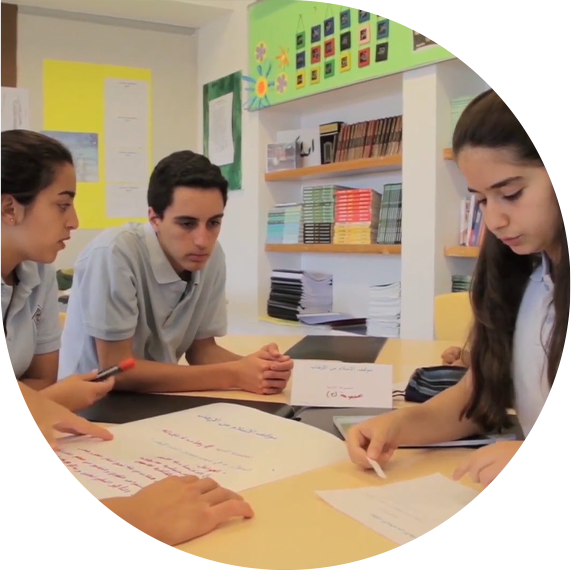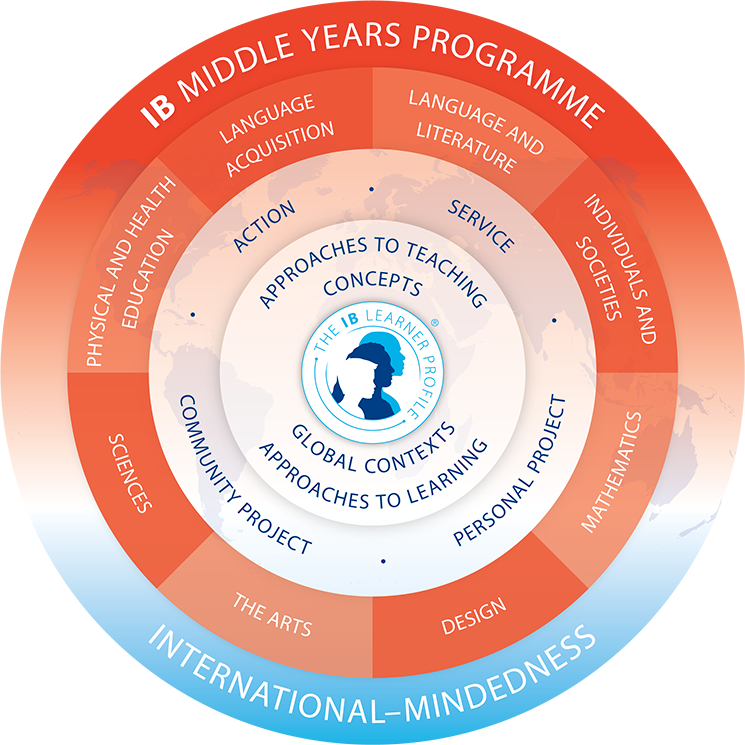In the transition from adolescence to young adulthood, we guide our MYP students to expand the depth and breadth of their understandings.

Learning Programme
The IB Middle Years Programme (MYP)
The MYP curriculum framework comprises eight subject groups, providing a broad and balanced education for early adolescents.
The MYP requires at least 50 hours of teaching time for each subject group in each year of the programme. In years 4 and 5, students have the option to take courses from six of the eight subject groups within certain limits, to provide greater flexibility in meeting local requirements and individual student learning needs.
Each year, students in the MYP also engage in at least one collaboratively planned interdisciplinary unit that involves at least two subject groups.
MYP students also complete a long-term project, where they decide what they want to learn about, identify what they already know, discovering what they will need to know to complete the project, and create a proposal or criteria for completing it.

Language Acquisition
The Language Acquisition programme leads students to acquire applicable skills in additional languages such as Spanish and German. Unlike other subject areas, Language Aquisition is taught in “phases”, not acccording to grade level. The result is that students are more motived to learn along with others who have similar language levels.
| Spanish by Phase | German by Phase | |
| Phase 1 |
|
|
| Phase 2 |
|
|
| Phase 3 |
|
|
| Phase 4 |
|
|
| Phase 5 |
|
Language & Literature
The Language & Literature programme at TOIS aims to engage students with a wide variety of literary works and multimedia texts, and provide the linguistic tools necessary to authentically engage with and respond to those texts, for a variety of purposes, audiences, and expectations.
By gaining exposure to big ideas, students make broad connections through focused anchor points, looking at global issues through local and personalized lenses.
The Language & Literature programme at TOIS identifies key competencies as:
- Receiving meaning through active engagement with visible and audible texts (reading, watching, and listening)
- Producing meaning through active creation of spoken, written, and visual texts (writing, speaking, and showing)
- Thinking about meaning critically as well as creatively, and demonstrating critical thinking in a wide manner of creative responses
- Using engagement and creation to relate to others and expand one’s worldview beyond the self
- Active reflection on the learning experience over time to demonstrate progress, development, and achievement
- Participating and contributing to personal, cultural, and social knowledge, inquiry, and understanding
| MYP 1-5 |
Learners read, listen to, and watch a variety of literary and nonliterary works at a variety of levels that develop in complexity, scope, and depth over time. Moving through the spectrum of Bloom’s Taxonomy and increasing their conceptual awareness, learners shift from recognizing overt, explicit meaning, to uncovering covert, implicit meaning, using the texts themselves as the evidence and support for creating their own increasingly complex evaluations. |
Individuals and Societies
History
MYP History is an exploratory World History program that encourages students to cultivate a sense of investigative inquiry into the past. Students will investigate not only what happened, but why it happened. Exploring History gives students a unique global understanding of who we are as global citizens and builds tools for helping them understand the present.
| MYP 1: History |
Establishes and reinforces the tools needed for investigative inquiry by looking at the Medieval era. |
| MYP 2: History |
Continues the journey of exploration by looking at the Early Modern Era to include the Industrial Revolution. |
| MYP 3: History |
Continues the exploration of the concepts of History while investigating the First and Second World Wars. |
| MYP 4: History |
With more emphasis on a conceptual understanding of History, students will receive a foundation in Ancient History, the Industrial Revolution and the two World Wars. |
| MYP 5: History |
A continued investigation of conceptual History Highlights the Modern Era with an intense focus on research and reporting. |
Geography
MYP Geography leads students to discover the three main areas of physical, human and regional geography. By focusing on relationships between humans and the natural landscape, students explore of a variety of concepts such as Change, Global Interactions, Time Place and Space, and Development.
Students consider the world around them by looking at how individuals and communities interact with, and use the resources of, human and natural landscapes. Examples of how natural processes affect people in a variety of ways as well as how people have adapted to manage various natural processes are important themes throughout MYP.
Geography themes in each year of study:
| MYP 1: Geography |
|
| MYP 2: Geography |
|
| MYP 3: Geography |
|
| MYP 4: Geography |
|
| MYP 5: Geography |
|
MYP 4-5 Humanities
The Humanities engage MYP 4-5 students in critical thinking with a range of topics spanning from Philosophy to Politics, and provides as a continuum to some of the subjects in the Diploma Program, such as Psychology, Economics, and Business Management.
| MYP 4: Humanities |
|
| MYP 5: Humanities |
|
Science
MYP students learn to apply the scientific method and their innate sense of curiosity to explore the world around them. Students test their hypotheses, both in the laboratories and outside them, interpreting data and numbers to reach clearer conclusions and deeper understandings.
| MYP 1 – 3 Science |
|
| MYP 4 – 5 Science |
|
Mathematics
Learners in the MYP mathematics program engage with relevant, rich and interesting investigations, and develop critical, creative, logical, and computational thinking.
By applying a wide variety of mathematical problem-solving techniques, students learn to communicate mathematical ideas accurately and clearly, and solve challenging real life and abstract problems.
| MYP 1: Mathematics |
|
| MYP 2: Mathematics |
|
| MYP 3: Mathematics |
|
| MYP 4: Mathematics |
|
| MYP 5: Mathematics |
|
The Arts
Performing Arts
Performing Arts inspire students to express themselves through music, theatre and dance. MYP 4 and MYP 5 in particular focus on learning guitar and actively performing music. There is a strong emphasis on the creative process, with students exploring music in connection with their individual interests. MYP students participate in Performing Arts lessons once a week in 90-minute blocks in the specially equipped Apollo room.
The program incorporates strands of performance, music literacy, improvisation & creation, dance, theatre and appreciation.
| MYP 1 |
|
| MYP 2 |
|
| MYP 3 |
|
| MYP 4 |
|
| MYP 5 |
|
Visual Arts
The Visual Arts provide a variety of new perspectives on society and the world we live in. As a core subject, it links naturally to other subject areas, inspiring students to be knowledgeable and to experiment.
The Visual Arts program at TOIS develops:
- Observational and analytical thinking
- Practical motor skills and coordination
- The connection and transfer of knowledge and ideas
- Motivation and self-control
- Cultural expression
- Material experimentation
- Reflection and quality evaluation
Units of study:
| MYP 1 |
|
| MYP 2 |
|
| MYP 3 |
|
| MYP 4 |
|
| MYP 5 |
|
Physical and Health Education
The Physical and Health Education (PHE) programme at TOIS aims to empower students to understand and appreciate the value of being physically active and to develop the motivation for making healthy choices.
In PHE, MYP students learn to:
- Engage in team-building, and develop motivational and communication skills needed for working together
- Develop the motor skills necessary to take part in a variety of physical activities
- Demonstrate an understanding of the principles of physical activities and a healthy lifestyle
- Reflect upon and evaluate their own performance in order to set goals for future development
| MYP 1-5 Physical and Health Education |
Learners develop and apply a range of skills and techniques for effective performance, physical health, and well-being, by designing, explaining and justifying their own improvement plans. Across the MYP, students engage in a wide variety of sports and physical activities, including:
The topics related to health and wellbeing include:
|
Design
Design lessons fuse creativity and imagination into a project planning mindset. Using the Design Cycle, MYP students learn how to plan both big and small projects from start to finish. In one 90-minute block a week, students learn to implement the four main areas of the design cycle: Inquiry & Analysis, Developing Ideas, Creating the Solution, and Evaluating.
| MYP 1 |
|
| MYP 2 |
|
| MYP 3 |
|
| MYP 4 |
|
| MYP 5 |
|
Discover
We work hard to harness the natural energy and enthusiasm of adolescent learners and provide encouragement, guidance, and expertise to help broaden and deepen their knowledge and skills.
Connect
By making cross-curricular connections, students have the chance to develop their unique voices, and to take charge of the choices they make.
Achieve
Students learn and reflect upon real-world contexts, and complete the Middle Years Programme with the Personal Project Exhibition – great preparation for the Diploma Programme.